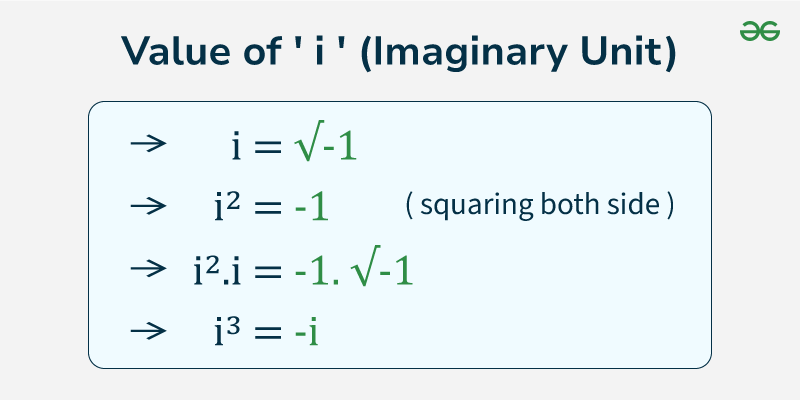
|
|
The value of i is a fundamental concept in mathematics, especially in the field of complex numbers. Mathematics extends beyond real numbers to include complex numbers, which are represented using the imaginary unit i, also known as iota. The concept of i both amazes and confuses students and mathematicians In this article, we will explore the concept of i and its value. We will also examine how i is used to represent complex numbers. To aid in understanding, we will provide the value of i, i^2, i^3, and i^4 with solved examples that illustrate these concepts in practice. 
Table of Content What is the value of ‘i’?The term ‘i’ is referred to as an imaginary number or iota. It is used to represent numbers that are not real but form an integral part of a mathematical system. This came into the picture when there are negative values in the square root. The value of ‘i’ can be represented as
Since the value of √-1 can’t be calculated, it is represented by the term ‘i’. Value of i Definition
What is value of i in Complex Numbers?We can use ‘i’ to represent real and complex numbers, here is a generalized representation:
If the number z is purely imaginary then x = 0 and if the number z is real then y = 0. Geometrical Interpretation of iLet us see how we can graphically represent a complex number in the complex plane:  Complex numbers in the complex plane
What is Absolute Value of i?When we refer to the absolute value of a number, it is the modulus value of the number. We know that the absolute value of both 1 and -1 is 1 therefore, we the absolute value of i is 1. The absolute value of complex numbers can be term as:
For the imaginary unit i, which can be represented as 0 + i,
So, the absolute value of i is ∣i∣ =1. What is Value of Powers of i (i2, i3, i4…)?Now let us manipulate the properties of i and see what happens when we repeatedly multiply the number ‘i’. Note that if we take the square of any real number, the value always comes out to be positive which is not the case with the complex number ‘i’. Let us see this from the table.
General ResultsFrom the above table, we can generalize that i is a cyclic expression that repeats its value after four intervals which can be given by
Properties of iLet us take a look at some properties of i
Related Articles: Solved Examples of the Value of iExample 1: Evaluate the value of expression √-6 Solution:
Example 2: Find the value of √49 + √-8 Solution:
Example 3: Find the value of x+y if x= √49 + √-8 and y=-2i√2. Solution:
Example 4: Find the quadrant where x = √36 + √-4 lies on a complex plane. Solution:
Example 5: Find the value of x × y if x = √49 + √-8 and y =√49 – √-8. Solution:
ConclusionThe value of i is a fundamental concept in mathematics that extends our understanding of numbers beyond the real number line. Defined as [Tex]\sqrt{-1}[/Tex], the imaginary unit i is essential in representing complex numbers and exhibits a cyclic pattern in its powers. By exploring its properties, geometrical interpretation, and practical applications, we see how i plays a crucial role in various fields such as electrical engineering, quantum mechanics, and complex number theory. This guide helps demystify i, providing a solid foundation for further mathematical studies. FAQs on Value of iWhat is the magnitude of a complex number a+ib?
What will be the value of i58?
In which quadrant will the number 6-8i lie in the complex plane?
In which quadrant will the number 5-6-8i lie in the complex plane?
How can we represent real numbers using i?
What are the absolute values of-2+i and 2+i?
|
Reffered: https://www.geeksforgeeks.org
| Class 11 |
Type: | Geek |
Category: | Coding |
Sub Category: | Tutorial |
Uploaded by: | Admin |
Views: | 17 |